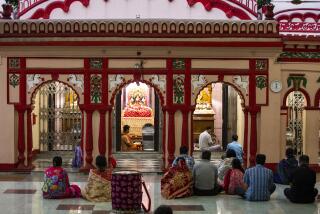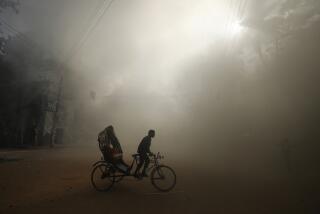Bangladesh Is No Basket Case : A Growing Economic Power, It’s Self-Reliant--Even in Disaster
- Share via
The time has come to quit feeling sorry for Bangladesh. With news of its annual flood fresh in mind, it now behooves us to be skeptical of the well-oiled public-relations efforts of the large numbers of relief agencies that depend on such disasters to raise funds for their programs. In truth, Bangladesh’s latest disasters are nowhere as serious as its disasters used to be. The Bangladesh embassy in Washington reported 1,165 deaths related to this flood and 158 other mortalities caused by diarrheal diseases. Neither figure is high compared with those of the past (there were 1,500 flood-related deaths in 1987), despite the unprecedented level of this year’s flooding.
We must keep in mind that such numbers are directly tied to a fund-raising effort that, aside from those of Israel and the Contras, is without peer in the annals of foreign-aid and relief campaigns. Indeed, what would be news about Bangladesh would be the absence of annual monsoon rains and extensive flooding, for that would result in a devastating drought and mass starvation.
What is news about Bangladesh is the fact that, while it is one of the world’s poorest countries, it is rapidly becoming one of those pesky exporting Asian nations that so bedevil the United States’ trade balance by flooding our shopping malls with an ever-growing variety of well-made products. In the past five years Bangladesh has moved from 28th to 5th place in garment exports to the United States. Moreover, it is starting to export electronic goods, including TVs and VCRs, along with light bulbs and machine-tooled hardware.
If this sounds like a repetition of what happened in South Korea, Taiwan, Hong Kong and Singapore, it’s because that’s what it is: Bangladesh is going through the same process of development. From relative poverty and the ravages of war, another group of gritty, determined people--this one living on the delta of two of the world’s largest rivers--is rapidly industrializing, urbanizing, modernizing and exporting into the world market.
More interesting is the fact that South Korea--as well as other East Asian countries including Japan, Hong Kong, Singapore and Thailand--is pouring aid and investment into Bangladesh to take advantage of the inexpensive, high-quality labor available there.
Thus the real news is that, while the Bangladesh of the relief agencies still exists, it is transforming itself rapidly into the Bangladesh of self-reliance. Almost unbelievable is the fact that, according to government figures, Bangladesh is 94% self-reliant, thanks in large part to the fact that production of grain and other food is growing faster than population.
As to the ravages of nature, these, too, are being mitigated successfully--in large part due to the construction and use of a vast system of warehouses where emergency stocks of food and anti-diarrheal remedies are stored before each flood season. These warehouses have been built in 460 counties--a testament to the foresight and policies of Bangladesh’s first two leaders, Presidents Mujibur Rahman and Zia Rahman. Under the current president, H. M. S. Ershad, the emergency supply system was completed and made virtually disaster-proof via an excellent telephone microwave communications system. It is functioning at a high level of competence, and is growing stronger all the time.
Thanks to such planning and execution, this year’s unprecedented out-of-season flood did not cause anywhere near the extent of starvation and death that one would have expected.
What gives Bangladesh the foundation for such self-reliance is its extensive resources. The country has a 200-year supply of natural gas, which is used to produce energy and fertilizer (as well as fuel for home cooking). With the recent opening of the Chittagong fertilizer factory, Bangladesh now is exporting fertilizers to Southeast Asia. In addition, there are extensive coal resources, as well as extremely fertile soil and an excellent climate, which made possible the nation’s successful tea- and jute-growing activities. Even the annual monsoon is a resource of unparalleled value in its contribution to maintaining self-sufficient food production.
The time is approaching--as was the case with Taiwan, Hong Kong, South Korea and Singapore--when we will stop reaching for our checkbooks to help Bangladesh and instead will seek to protect our pocketbooks. It is such news from Bangladesh that we should be concentrating on: the fact that, thanks to all the aid that we and others have given in the past as well as to Bangladesh’s own determination and hard work, the former “basket case” is beginning to succeed and someday will thrive in a world of free trade.
Thus, if we want news from Bangladesh, our reporters would do better to train their cameras on their plush hotel rooms instead of on exotic devastated vistas. Indeed, the emphasis on routine natural disasters without reporting on the success that occurs in between those disasters gives a picture of an unstable nation and thus discourages the investment that is desperately needed for further employment opportunities and economic growth. Only with such balanced information would we truly see the contrast between the old news and the newnews about this 17-year-old nation. If you have any doubts about this, just examine the labels at your local K-Mart the next time that you’re in the market for clothes.
More to Read
Sign up for Essential California
The most important California stories and recommendations in your inbox every morning.
You may occasionally receive promotional content from the Los Angeles Times.










